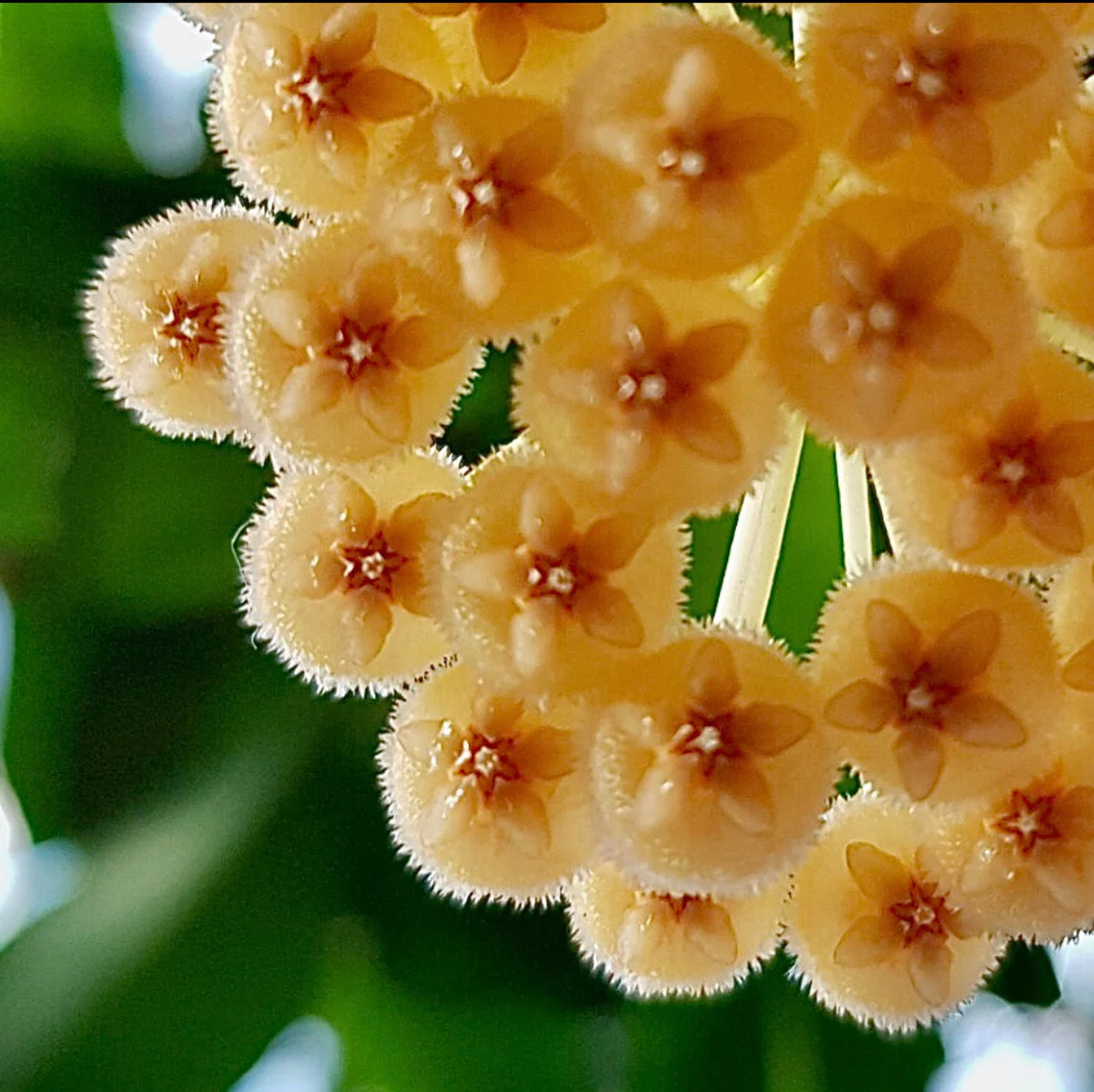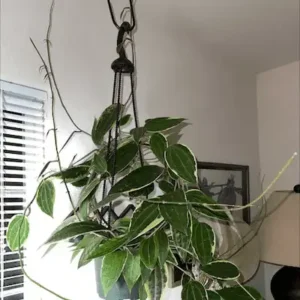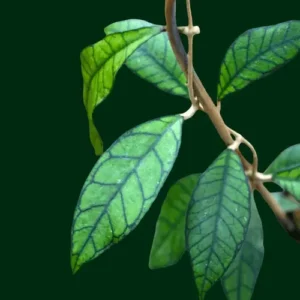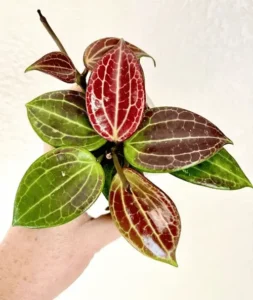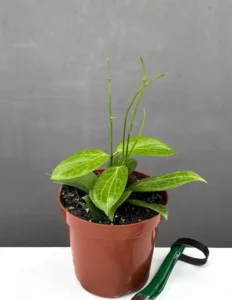Description
Hoya obscura (red wax plant) is a fast-growing hoya with medium-sized leaves. These vined leaves range from deep green when grown in shade and in case of sunlight, they grow to a deep reddish color. However, this red wax plant is easy to grow. It’s native region is the Philippines. This wax plant is mostly found in dipterocarp forests.
Properties
Scientific name: Hoya Obscura
Common name: Red wax plant and porcelain flower
Light requirements: Bright, indirect sunlight
Temperature requirements: 60°F and 85°F(16°C – 29°C)
Propagation: By stem cuttings
Facts
– Climbing epiphyte
Due to its enduring capability, Hoya Obscura (red wax plant) is considered a climbing epiphyte. It primarily grows in a wet tropical habitat.
– Choose a suitable pot
For a healthy and happy hoya, mimic its natural warm habitat and choose a suitable pot according to hoya size. Choose a 4-6 inch pot for seedlings, 10-12 for mature plants for effective growth, and sufficient drain holes. In addition, to prevent root rot use pots with 2-3 holes.
– Thrives in indirect sunlight
In general, hoyas prefer to be grown in bright, indirect sunlight. Direct sunlight will scorch its delicate leaves. So, keep your hoya away from direct sunlight for enough growth.
– Re-pot conditions
In general, hoyas like to be a bit pot-bound. They hate to be disturbed, so don’t disturb it. Only report it under suitable requirements.
Requirements for the better growth of Hoya Obscura (red wax plant)
Here is a list of the requirements for the better growth of the hoya obscura plant.
Soil requirements for Hoya Obscura (red wax plant)
– Soil should be well-drained and well-aerated potting that is gently acidic, as hoya plants don’t like moist soil that leads to root rot which is the most prominent problem among hoyas. Moreover, Root rot may result from the container holding too much water if the plant is not kept root-bound.
– Additionally, overwatering may prevent the plant from flowering. However, between watering, allow the soil to dry out. Spring and summer are the most effective seasons for growing the hoya plants. During these seasons, hoya plants require more watering than sleepy wintertime.
Care requirements for Hoya Obscura (red wax plant)
Here are some care requirements for this beautiful porcelain flower as watering, light, temperature, and humidity-like conditions that you should follow.
Watering conditions for Hoya Obscura (red wax plant)
Don’t overwater the hoya. In case of overwatering, there will be the risk of root rot which stops the growth of this durable houseplant.
Light conditions for Hoya Obscura (red wax plant)
For effective growth provide bright, indirect sunlight with stable room temperatures of 60°F and 85°F (16°C – 29°C). Although, this hoya doesn’t like direct sunlight, put this red wax plant in a place where no direct sunlight comes for effective growth.
Temperature and humidity conditions for Hoya Obscura (red wax plant)
There should be stable room temperatures of 60°F and 85°F (16°C – 29°C) and humidity below 60 for enough growth of this red wax plant..
Blooming and flowering tips for Hoya Obscura (red wax plant)
Here is a list of blooming and flowering tips for the hoya obscura plant.
Importance of a fertilizer
During the growing season (spring and summer), feed your Hoya with a balanced, water-soluble fertilizer every 4-6 weeks. Moreover, a fertilizer higher in phosphorus can help encourage blooming.
Importance of light and watering conditions
Provide bright, indirect sunlight and let the hoya dry between the waterings. However, Don’t overwater the hoya because hoyas like moist or well-drained soil, not wet soil.
Importance of temperature and humidity
Provide humidity below 60, not more than that, and stable room temperatures of 60°F and 85°F (16°C – 29°C) if you want to encourage this red wax plant to bloom. In case of the below 16°C temperature, your hoya obscura will be died.
Problems with Hoya Obscura (red wax plant)
Aphids, spider mites, mealybugs, and fungus issues with hoya Obscura (red wax plant)
Aphids, spider mites, and mealybugs
-The hoya plant is harmed by mealybugs, spider mites, and aphids. Root rot may result from the container holding too much water if the plant is not kept root-bound. Additionally, overwatering may prevent the plant from flowering.
-Thinning, brown, or wrinkled leaves can mean that the plant is allowed to dry too much between watering.
Mold and fungus
-Mold and fungus which are the silent invaders discoloration or powdery spots on leaves are also common problems. It is also susceptible to a range of common ‘sap-sucking’ houseplant pests including aphids, mealybugs, scale and spider mites.
-Hoya fungal leaf spot and other fungal or bacterial diseases commonly affect this type of plant which is caused by brown spots on the leaves.
Root rot issue with Hoya Obscura (red wax plant)
Root rot is a common disease caused by overwatering and poor drainage.
Solutions to these problems
Here is a list of some solutions related to these problems.
-Use neem oil, check plants frequently, keep leaves clean, apply rubbing alcohol, steer clear of overwatering, and introduce natural predators to ward off aphids, mealybugs, and spider mites.
-Most “soft” insecticides and biological agents, which are easily accessible to home gardeners, can be used to control insects and pests.
-Leptomastix dactylopii and Anagyrus fusciventris are parasitic wasps that can be released into an affected area to suppress wilted leaves effectively.
-Water your hoya obscura weekly and provide enough humidity for optimal growth.
Methods of propagation
Propagation by stem cuttings
Hoya Obscura (red wax plant) is propagated by stem cuttings. Usually, hoya plants are propagated by stem cuttings in water or soil. For better propagation, take a healthy stem and cut below a leaf node with no defect. For successful rooting provide bright light, warmth, and enough humidity. Additionally, pot up the hoya after the roots have been established, ensuring a smooth transition with high humidity.
Essential and optional aids
-On the other hand, some essential and optional aids can also enhance the propagation success rates, like, Using a popsicle-making container (fancy propagation equipment!) for the rooting because it holds the leaves up above the rim.
– Keep water in the container just above the bottom node and when the roots appear, make sure they’re covered too and remove all leaves, those at the top of shorter stem cuttings (no more than 1, 2, or 3 nodes) while rooting in a mixture.
FAQs How to grow Hoya obscura? Hoya obscura thrives in bright, indirect sunlight and enough humidity levels with stable room temperature. Soil should be well drained. Hoyas dislike moist soil. Provide dry environments. Don’t overwater your hoya, if you do it will lead to root rot. Why is a Hoya plant so expensive? The Hoya plant is expensive due to its limited availability and high demand from collectors. Irrespective of its limited availability, this wax plant is usually found to be in many nurseries and plant shops. Is the Hoya plant good for home? Hoya plant due to its low- maintenance and easy-to-care requirements, is the best choice for indoor gardening. |
Conclusion
In conclusion, Due to its enduring capability, Hoya Obscura (red wax plant) is considered a climbing epiphyte. Hoya obscura (red wax plant) is a fast-growing hoya with medium-sized leaves. These vined leaves range from deep green when grown in shade and in case of sunlight, they grow to a deep reddish color.

